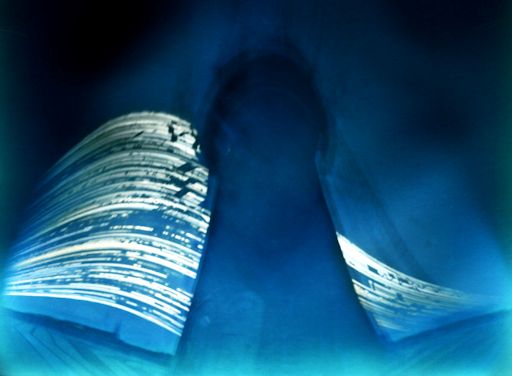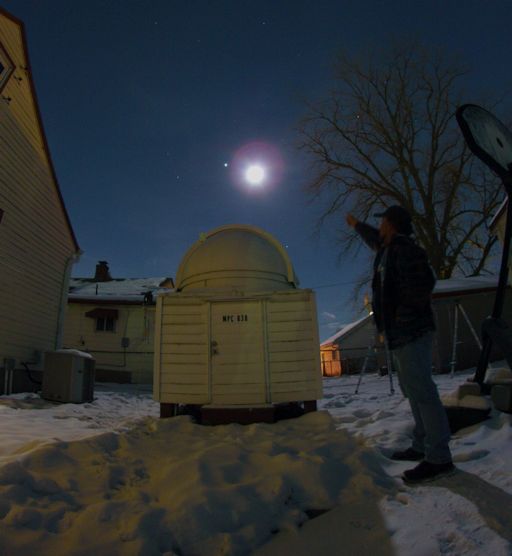Listen to radar echoes from satellites and meteors, live on listener-supported Space Weather Radio. | | |
EDGE OF SPACE CHRISTMAS CARDS: What do you give to the sky watcher who has everything? How about a Christmas card from the Edge of Space? For only $49.95, the students of Earth to Sky Calculus will fly your holiday greeting or favorite picture to the top of Earth's atmosphere, photograph it, and return the snapshot in time for the holidays. It's a unique gift! The group has previously flown cupcakes, shoes, US presidents, ad banners and telescopes. This holiday magic is performed using suborbital helium balloons. Contact Dr. Tony Phillips for more information.
SOLSTICES IN A BEER CAN: The northern winter solstice is only two days away. In the Netherlands that means it's time to open up a beer can and look inside. Every six months, Jan Koeman of Zierikzee, the Netherlands, deploys a beer-can solargraph to record the progress of seasons, solstice to solstice. Yesterday he cracked his open and this is what he saw:

"I made a solargraph using an empty beer tin with a pinhole and photographic paper inside," explains Koeman. "The exposure time is 6 months!"
The highest arcs were traced by the summer sun ofJune 2013. The lowest arc was made by the sun yesterday almost on the eve of the 2013 winter solstice. Occasional gaps are caused by clouds.
"This year I placed my solargraph high and safe on an old Dutch windmill," continues Koeman. "The miller is always busy and we have a lot of wind here, so the spinning wings of the mill are barely visible in the photo."
Readers: Northern winter begins on Dec. 21st at 17:11 UT. Now is the perfect time to deploy your own beer-can solargraph for the next six months. Too young to drink? Soda cans work, too. 6-month Solargraph How-to Guides: #1, #2, #3
Realtime Space Weather Photo Gallery
BRIGHT LIGHTS IN THE NIGHT SKY: If it's dark where you live, go outside and look up. Jupiter and the Moon are having a close encounter in the constellation Gemini, only 5 degrees apart. Amateur astronomer John Chumack points them out from his observatory in Dayton, Ohio, on Dec. 18th:

"After receiving the alert from the spaceweather.com, I just had to step outside and see these bright celestial objects. WOW, it was a nice view," says Chumack.
The Moon and Jupiter are drifting apart now, but they will continue to form a visually pleasing pair for the next 12 to 24 hours. Take a look.
Realtime Space Weather Photo Gallery
THE LONG TAIL OF COMET LOVEJOY: Next week, Comet Lovejoy makes its closest approach to the sun. The comet's tail is already amazing. Scroll down this image taken by Gerald Rhemann of Jauerling, Austria, for more information:

Filled with knots and eddies of dusty plasma, Lovejoy's tails stretches more than 20 degrees across the sky--long enough to overlap 40 full Moons or fill the Bowl of the Big Dipper twice. At closest approach to the sun or "perihelion" on Dec. 23rd, the comet will be just inside the orbit of Earth (0.82 AU). The extra heating it gets at perihelion will grow the tail even more.
Comet Lovejoy shines like a 4th magnitude star so it is barely visible to the unaided eye (especialy when the sky is filled with full moonlight). However, for backyard telescopes, the comet is a fairly easy target rising ahead of the sun in the eastern morning sky. If you have a GOTO telescope, send it to these coordinates. Slight pointing errors are no problem, because the tail is almost too broad to miss. Sky maps: Dec. 18, 19, 20. Backyard astronomy alerts: text, voice
Realtime Space Weather Photo Gallery
Realtime Aurora Photo Gallery
Realtime Comet Photo Gallery
Every night, a network of NASA all-sky cameras scans the skies above the United States for meteoritic fireballs. Automated software maintained by NASA's Meteoroid Environment Office calculates their orbits, velocity, penetration depth in Earth's atmosphere and many other characteristics. Daily results are presented here on Spaceweather.com.
On Dec. 19, 2013, the network reported 29 fireballs.
(24 sporadics, 2 Comae Berenicids, 2 December Leonis Minorids, 1 sigma Hydrid)

In this diagram of the inner solar system, all of the fireball orbits intersect at a single point--Earth. The orbits are color-coded by velocity, from slow (red) to fast (blue). [Larger image] [movies]
On Dec. 18, 2013, the network reported 12 fireballs.
(10 sporadics, 1 sigma Hydrid, 1 December Leonis Minorid)

In this diagram of the inner solar system, all of the fireball orbits intersect at a single point--Earth. The orbits are color-coded by velocity, from slow (red) to fast (blue). [Larger image] [movies]
Potentially Hazardous Asteroids (
PHAs) are space rocks larger than approximately 100m that can come closer to Earth than 0.05 AU. None of the known PHAs is on a collision course with our planet, although astronomers are finding
new ones all the time.
On December 19, 2013 there were potentially hazardous asteroids.
Notes: LD means "Lunar Distance." 1 LD = 384,401 km, the distance between Earth and the Moon. 1 LD also equals 0.00256 AU. MAG is the visual magnitude of the asteroid on the date of closest approach. | | The official U.S. government space weather bureau |
| | The first place to look for information about sundogs, pillars, rainbows and related phenomena. |
| | Researchers call it a "Hubble for the sun." SDO is the most advanced solar observatory ever. |
| | 3D views of the sun from NASA's Solar and Terrestrial Relations Observatory |
| | Realtime and archival images of the Sun from SOHO. |
| | from the NOAA Space Environment Center |
| | the underlying science of space weather |

